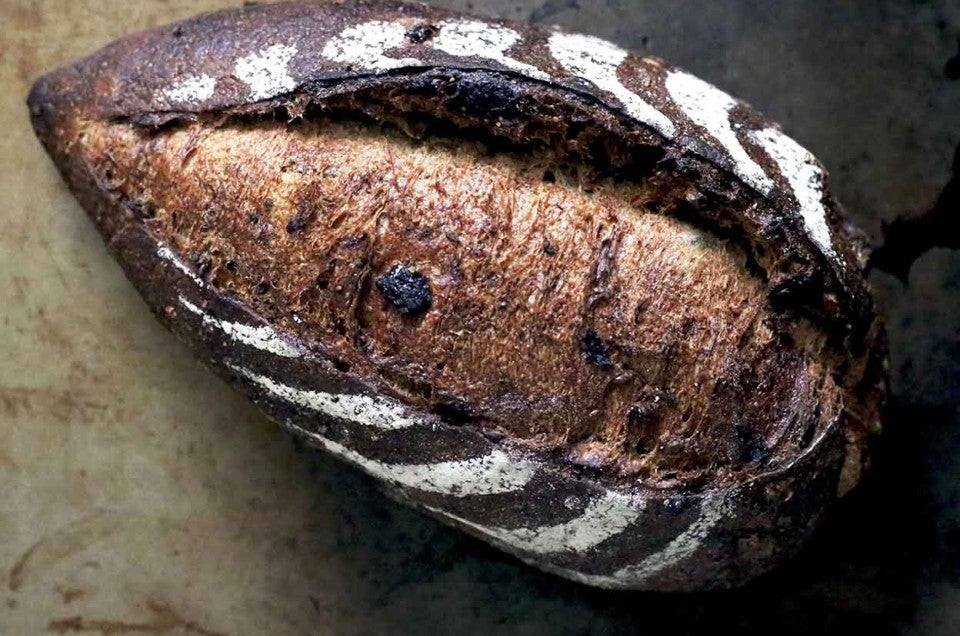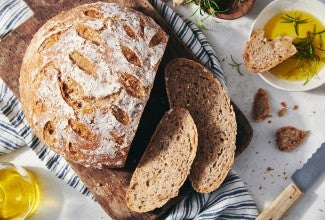-
To make the preferment: Weigh your flour; or measure it by gently spooning it into a cup, then sweeping off any excess. Mix the flour, water, and sourdough starter until thoroughly combined. Cover and let rest at room temperature for 12 to 16 hours; the dough will be nice and bubbly.
-
To make the soaker: Toast the cracked wheat in a skillet set over low heat until the grains are lightly browned, and smell toasty. Combine the wheat and water, and let rest overnight.
-
To make the dough: In a large bowl, combine the flours and yeast, then stir in the water, mixing until no dry bits remain. If you're using a stand mixer, this may take up to 3 to 4 minutes at low speed.
-
Let the dough rest in the bowl, covered, for 20 minutes.
-
Add the preferment, soaker, and salt, mixing until fully incorporated. Mix for 6 to 7 minutes at medium-low speed; the dough should be smooth (aside from the cracked wheat) and elastic.
-
Add the fig and anise seed, mixing on low speed until evenly distributed. The dough may be quite stiff; that's OK.
-
Check the dough temperature; it should be between 75°F and 80°F. This is the optimum temperature for rising dough, so try to find a spot that's around that temperature.
-
Cover the bowl, and let the dough rise for 15 minutes. Give the dough its first fold by reaching into the bowl and pulling a corner of dough up, folding it back toward the middle, and pushing it down. Repeat, working your way around the dough ball, for a total of 4 to 6 times. This will both de-gas the dough, helping the yeast to work; and strengthen the dough's structure.
-
Repeat folding the dough after another 15 minutes (at the 30-minute mark since it started rising), and once more at the 45-minute mark.
-
Let the dough rise for 90 to 120 minutes, or until it's noticeably puffy, though perhaps not doubled in bulk.
-
Gently deflate the dough, and divide it into two pieces about 560g each.
-
Gently pre-shape the pieces by gathering the corners of the dough and folding them to the center to form a loose ball. Place the balls, seam-side down, on a very lightly floured surface, cover, and let rest for 10 to 15 minutes.
-
Working with one piece of dough at a time, shape as a batard with tapered points. Tuck one end underneath to create a teardrop shape. Place seam-side up on a flour-dusted couche or smooth cotton towel. Repeat with the second piece of dough. Need help shaping? See our tips for shaping a batard video.
-
Gently cover the loaves, and let them rise for about 60 minutes, until they're puffy.
-
While the loaves are rising, preheat your oven to 450°F, with a baking stone on the middle rack. Place a cast iron pan on the oven's lowest rack; you'll use it to create steam.
-
To bake on a stone: Roll the proofed loaves, seam-side down, onto a peel dusted with semolina or whole wheat flour. If you aren't using a stone, roll them onto a parchment-lined baking sheet, seam-side down.
-
Score the dough with a baker's lame or very sharp knife, cutting an arc from the midpoint of the tip to the midpoint of the base.
-
Add 1 cup boiling water to the cast iron pan. Quickly use the peel to load the loaves onto the stone (or place the pan in the oven), and close the door.
-
Bake the loaves for 32 to 37 minutes, or until they're a rich mahogany color. The top crust will feel firm, and the bottom crust will be robust, but not burned. If you have a digital thermometer, the loaf's center temperature should be about 200°F.
-
Remove the loaves from the oven, and transfer them to a rack to cool.


















